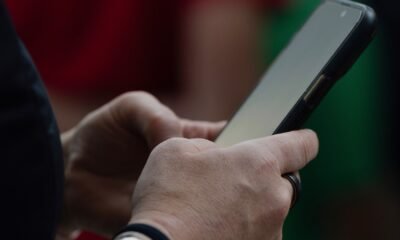Middle East
After Israel’s bombs, Nabatieh’s Monday Market revives itself once again | Israel attacks Lebanon

Nabatieh, Lebanon – It is a bitterly cold February morning, and Sanaa Khreiss tugs her cardigan tighter as she begins unloading her van.
The sharp bite of early spring has kept most people away from the Nabatieh souk, but not Sanaa and her husband, Youssef.
The market is quiet as the sun breaks through the grey clouds, except for a few vendors setting up.
Sanaa, who has sold at this spot for the past four years, moves with the calm precision of someone who has perfected her craft over time.
She arranges the lingerie she sells, piece by piece, carefully lining them up, each addition bringing a touch of colour and vibrancy to her stall.
The soft murmur of voices grows as more vendors arrive, helping each other set up canopies to shield their stalls from potential rain.
The task is far from easy. The wind tugs at the fabric, and some canopies still hold water from the recent rainfall. But they press on, and slowly, the white shapes pop up, and Nabatieh’s Monday Market has started.
Sanaa smiles at the occasional passer-by, her warmth never fading. She has come to know many by name and can anticipate their requests. Her voice is quiet but inviting.
“I choose the Monday Market because there’s always a lot of movement, and it’s a historic, popular spot in the south,” Sanaa tells Al Jazeera, her fingers brushing over lace and satin as she unpacks more items from the van.

In the stall next door, her husband Youssef works in silence. His movements are precise, almost meditative, but there is a hint of tension in how he arranges the containers and cookware.
Youssef has never imagined himself here; he used to be a driver for the Khiam municipality, but lost his job when the municipality ceased operations after the outbreak of the Israeli war on Lebanon in 2023, which particularly devastated Lebanon’s south, including Nabatieh, one of the region’s biggest cities.
Since then, Youssef has quietly adapted to the life of a vendor beside Sanaa.
Youssef is quiet and reserved, a stark contrast to Sanaa’s extroverted warmth. He focuses intently on his tasks, but when approached by a customer, his blue eyes shine with welcome, and his voice is friendly.
At first glance, no one would guess the weight those eyes carry – war, displacement, losing his livelihood and their home in Khiam. But at the market, it is business as usual.
The market
Shoes, toys, spices, clothing, books, food, electronics, and accessories – the Monday Market sells all that and more.
The Monday Market in Nabatieh has its roots in the late Mamluk era (1250–1517 AD) and continued to thrive under Ottoman rule. Along with the Souk of Bint Jbeil and the Khan Market in Hasbaiyya, it is one of the oldest weekly markets in south Lebanon, established as part of efforts to extend trade routes across the region.
Back then, traders moved between Palestine and Lebanon, transporting goods by mule and donkey over rough, slow roads. Nabatieh’s location made it a natural stop – a bustling centre where merchants from nearby villages would gather to buy, sell and rest before continuing their journeys. The market also sat along a wider network of internal pilgrimage routes, connecting Jerusalem to Damascus, Mecca and Najaf.

Nabatieh Mayor Khodor Kodeih recounts that merchants travelling between Palestine and Lebanon would stop at a “khan” – an inn that also served as a trading centre – on the site of the current market.
A khan typically featured a square courtyard surrounded by rooms on two levels, with open arcades. Merchants would rest, trade and display their goods there, gradually transforming the site into the bustling Monday Market.
Over time, the market has become more than just a place to buy and sell – it is a ritual that stitches together the social and economic fabric of southern Lebanon.
The area around the old khans expanded into a larger open-air souk. Israeli air strikes during the last war destroyed the original khans, but traces of the market’s past still remain. Today, the Monday Market spans three to four city blocks in central Nabatieh, surrounded by remnants of Ottoman-era architecture. While shops remain open throughout the week, the market itself is made up of temporary stalls and stands that operate only on Mondays.
Before Israel’s recent war on Lebanon, the market filled the streets, framed by Ottoman-era buildings with wooden shutters and iron balconies. Merchants packed the narrow alleys with vibrant goods, their calls for business filling the air. But on November 13, 2024, Israeli air strikes reduced the historic market to rubble. Stone arches crumbled, shopfronts burned, and what was once a bustling hub was left in ruins.

All that remains
Arriving at Sultan Square, the usual site of the old market, one is left confused. All that remains is a vast, empty space at the heart of the city.
The famous Al-Sultan sweet shop, after which the square was named, is gone. Nearby, other sweet shops – including al-Dimassi, established in 1949 and central to Nabatieh’s culinary identity and reputation – are also missing. They once sold staples of Lebanese dessert culture: baklava, nammoura, maamoul, and during Ramadan, seasonal treats like kallaj and an all-time favourite, halawet el-jibn.
Every market morning, merchants sweep the streets, using only brooms to push the debris to the sides and clear space for their stalls. Even as the wind blows rubble back towards their stand, they keep sweeping, determined to maintain a neat and orderly market.
Sanaa remembers the high-end lingerie shops that once competed with her; they’re gone too, reduced to debris amid which vendors have set up their tents as they wait for the municipality to clear the area.
There should be more vendors on that cold morning, but the rain and war have changed things.
“The good thing about rainy days,” Sanaa jokes, “is that there are fewer merchants, so customers have limited options.”
Before the war, she sold in bulk – new brides buying trousseaus, women stocking up. Now, purchases are small and careful – with homes and livelihoods lost, shopping is for necessity, not luxuries or impulse buys.
On a typical Monday, the market runs from 5am to 5pm. Merchants arrive early, making their way to their designated spots, some on the pavement, others against a backdrop of a collapsed building.
Vegetable vendors lay their produce out in large sacks and plastic crates. Normally, the market is so crowded with people that cars can’t pass and visitors have to squeeze past each other from one stall to the next.
Though profits aren’t what they used to be, Sanaa is just happy to be back. She’s kept her prices the same, hoping the market will rebound.
“This is the most important market in the south,” she says. “And we need to follow the source of our livelihood.”

‘Deep love story with the Monday market’
Next to Sanaa’s stall is Jihad Abdallah’s, where he has rigged up several racks to hang his collection of women’s sports clothes.
Yesterday’s snow is melting as the sun comes out, but Jihad keeps his hoodie up, still feeling the lingering cold.
Customers have started trickling over, but it isn’t enough to shake the frustrated, tired look on his face.
Jihad, from the border village of Bint Jbeil, spends his week travelling between different town markets in southern Lebanon to make ends meet.
He was among the first to set up in Bint Jbeil’s Thursday Market as soon as the ceasefire with Israel was announced on November 27, 2024. Jihad didn’t have many options. Bint Jbeil was the market he knew best – he memorised the rhythms, understood customer demands, and recognised how to turn profit. Still, business was slow.
“In Bint Jbeil, the market needs time to recover because many residents from nearby villages, like Blida, Aitaroun and Maroun al-Ras, haven’t returned yet,” Abdallah tells Al Jazeera.
“However, in Nabatieh, nearby towns have seen more returnees.”
Jihad was also among the first to return to the Nabatieh market, joining the very first band of merchants in clearing as much debris as they could manage.
“The Israelis want to make this land unliveable, but we’re here. We’re staying,” Jihad says. “They destroyed everything out of spite, but they can’t take our will.”
Further down the road, Abbas Sbeity has set up his stand of clothes for the day, a collection of children’s winter clothes he couldn’t sell because of the war.
“I had to empty my van to make room for mattresses for my kids to sleep on when we first escaped Qaaqaait al-Jisr [a village near Nabatieh],” he tells Al Jazeera, pointing to the van behind him, now packed with clothes.
Abbas is trying to make a profit, however small, from clothes that were meant to be sold when children returned to school last fall.
He’s been coming to the Monday Market for 30 years, a job passed down from his father, who inherited it from his grandfather.
“My grandfather used to bring me here on a mule!” he says with a nostalgic smile. For a moment, he stares off, lost in thought. His smile stays, but his voice holds a trace of sadness.
“There’s a deep love story with the Monday Market,” he adds. “But now, there’s a sadness in the air. People’s spirits are still heavy, and the destruction around us really affects their morale.”
Abbas remembers how people came not only to buy but to hang out for a weekly outing they could count on for fun, no matter the weather. Even if they didn’t buy anything, they’d enjoy the crowds or grab a bite, whether from the small shops selling manouches, shawarma, kaak or falafel sandwiches, or from a restaurant nearby, from local favourites like Al-Bohsasa to Western chains.
Many would also stop by Al-Sultan and Al-Dimassi, which were the closest to the market, to enjoy a sweet treat, a perfect way to top off their visit.
By noon, the rain had stopped, leaving behind a gloomy day as the sun struggled to break through the clouds, casting a faint light over the market. People haggled over prices, searched for specific sizes, and despite the changes brought by war, the Monday Market pressed on, determined to hold on to its place.

‘We won’t let them,’ determination versus reality
At one end of the Sultan Square, near the upper right corner, a half-destroyed building still stands where vendors used to set up shop before the war. Now, produce vendors arrange their stalls beneath it as if nothing had changed. The remnants of the structure loom above them – fragments of walls hanging precariously, held together by stray wires that look ready to snap.
Yet the vendors paid no mind, too absorbed in tending to customers. The building’s arched openings and ornate details, though battered, still hinted at the city’s rich past. Its verandas, standing like silent witnesses to the souk below, bore testament to both the scars of war and a culture that refused to disappear.
At the far end of the market, by the main road leading out of Nabatieh to nearby villages, one cart stands alone, piled high with nuts and dried fruits. Its owner adds more, making the stacks look like they might spill over at any second.
Roasted corn, chickpeas, and almonds sit next to raw almonds, hazelnuts, cashews and walnuts. Dried fruits are displayed front and centre, dates and apricots taking the spotlight.
At the back of the cart, Rachid Dennawi arranges candies – gummy bears and marshmallows in all shapes and flavours. It’s his first day back at the Monday Market since the war began.
Abir Badran, a customer dressed in a dark cardigan and a long black scarf that gently frames her face, is the first to reach Rachid’s cart while he’s still setting up. Her face lights up as she leans in to examine the dates, carefully picking through them.
“Finally, you’re back!” she says, reaching for the dates – they’re bigger and better than what she can find at other places, she says.

Rachid, originally from Tripoli in Lebanon’s north, makes the three-hour journey to Nabatieh because he believes the market is livelier, has more customers.
Over time, Rachid has built a loyal clientele, and people like Abir swear by his dried fruit and nut mix.
“The people here are different,” he tells Al Jazeera, handing Abir a handful of almonds to taste. “They don’t just buy from you – they welcome you and want you to succeed.”
But Abir didn’t just come to stock up – she is there because the Monday Market has become an act of resistance.
“The Israelis want to sever our ties to this land,” Abir tells Al Jazeera. “But we won’t let them.”
While the optimism is clear, the reality on the ground is tough.
Merchants and residents are doing what they can with what they have. Some have relocated their shops or started new businesses, but some are stuck in limbo.
Mayor Kodeih estimates it will take at least two years to rebuild the market and is critical of the Lebanese government’s support.
“We will restore the market,” he says. “It won’t be the same, but we’ll bring it back.”
The mayor was injured in the Israeli strike on the municipality in mid-October, which killed 16 people; he is one of the two survivors.
It is not easy to leave the market behind – or Nabatieh.
Despite the destruction, the city hums with life: Shops are open, cafes are busy, and people lean in doorways, greeting passers-by with warm smiles and easy conversation.
The gravity of war has left its mark. The destruction is visible at every turn – a bookshop reduced to rubble, shops flattened to the ground – but it has not stripped away the city’s kindness or its sense of humour.
In front of a lot with nothing more than a gaping hole in it, a playful banner by the shop that used to stand there reads: “We’ll be back soon … we’re just redecorating.”
One of the paths out of the Sultan Square leads visitors northeast, into a quieter neighbourhood of cobbled streets, where cafes and small shops line the way. Here, people sip coffee and linger by storefronts, seemingly untouched by the devastation only steps away.
Turning back at the boundary between the two, the destruction that has decimated the market is more apparent, as is the loss to Nabatieh and southern Lebanon.
The market’s heyday will live on only in the memories of those who experienced it, younger generations will never have that same experience.

Middle East
Iran’s Khamenei slams US nuclear proposal, vows to keep enriching uranium | Nuclear Energy News

Iranian supreme leader says issue of uranium enrichment remains key to Tehran’s pursuit of energy independence.
Iranian Supreme Leader Ayatollah Ali Khamenei has pledged that Tehran will not abandon its uranium enrichment, rejecting a key demand in a United States proposal aimed at resolving a long-running dispute over Iran’s nuclear programme.
The comments were delivered in a speech on Wednesday as the US and Iran continue to negotiate the details of a possible new nuclear deal. The issue of uranium enrichment has remained a sticking point in the talks, with the US reportedly demanding a complete halt or low-level enrichment in exchange for the lifting of Western sanctions against Tehran.
“The US nuclear proposal contradicts our nation’s belief in self-reliance and the principle of ‘We Can,’” Khamenei said in his speech delivered on the commemoration of the death of the Islamic Republic’s founder, Ayatollah Ruhollah Khomeini, in 1989.
Khamenei said the issue of uranium enrichment remained key to Iran’s pursuit of energy independence.
“Independence means not waiting for the green light from America and the likes of America,” he said, adding that the US proposal was “100 percent against” the ideals of the 1979 Islamic revolution.
He said Tehran would not seek Washington’s approval for its decisions.
“Some people think that rationality means bowing down to America and surrendering to the oppressive power; this is not rationality,” Khamenei said.
“Why are you interfering in whether Iran should have enrichment or not? You cannot have a say.”
On Tuesday, Iranian President Masoud Pezeshkian also said that Tehran “would not abandon” the country’s scientific and nuclear rights, while disavowing nuclear weapons.
He said that those accusing Iran “are proliferating” weapons of mass destruction and destabilising the region with deadly weapons.
On Monday, the Reuters news agency had reported that Tehran was poised to reject the latest US proposal to end a decades-old nuclear dispute, quoting an unnamed diplomat as saying the proposal was a “non-starter” that fails to soften Washington’s stance on uranium enrichment or to address Tehran’s interests.
Tehran said it wants to master nuclear technology for peaceful purposes and has long denied accusations by Western powers that it is seeking to develop nuclear weapons.
US envoy Steve Witkoff, who heads the American delegation in talks with Iran, has said President Donald Trump opposes Tehran continuing any enrichment, calling it a “red line”.
A leaked United Nations report shows that Iran has ramped up production of enriched uranium near weapons-grade by 50 percent in the last three months. It is still short, however, of the roughly 90 percent required for atomic weapons, but still significantly above the 4 percent or so needed for power production.
Iran, however, has rejected the latest report from the International Atomic Energy Agency (IAEA), saying it is “politically motivated and repeates baseless accusations”.
Ira is currently grappling with multiple crises including a plunging currency, losses among regional militia proxies in conflicts with Israel, and rising fears of an Israeli strike on its nuclear sites.
A failure to get a new nuclear deal could see tensions further spike in a Middle East already on edge over Israel’s war in Gaza.
Middle East
Iraq’s Jewish community saves a long-forgotten shrine | Religion News

In a bustling district of Baghdad, workers are labouring diligently to restore the centuries-old shrine of a revered rabbi, seeking to revive the long-faded heritage of Iraq’s Jewish community.
Just a few months ago, the tomb of Rabbi Isaac Gaon was filled with rubbish. Its door was rusted, the windows broken, and the walls blackened by decades of neglect.
Now, marble tiles cover the once-small grave, and at its centre stands a large tombstone inscribed with a verse, the rabbi’s name, and the year of his death: 688. A silver menorah hangs on the wall behind it.
“It was a garbage dump, and we were not allowed to restore it,” said Khalida Elyahu, 62, the head of Iraq’s Jewish community.
Iraq’s Jewish community was once among the largest in the Middle East, but today has dwindled to just a handful of members.
Baghdad now has only one synagogue remaining, but there are no rabbis.
The restoration of the shrine is being funded by the Jewish community, at an estimated cost of $150,000.
The project will bring “a revival for our community, both within and outside Iraq”, Elyahu said.
With the support of Iraqi officials, she expressed hope to restore further neglected sites.
There is little information about Rabbi Isaac. During a visit to the tomb earlier this year, Iraq’s National Security Adviser Qasim al-Araji stated that the rabbi had been a finance official.
Rabbi Isaac was a prominent figure during the Gaonic period, also known as the era of Babylonian academies for rabbis.
The title “Gaon” is likely to refer to his role as the head of one such academy.
His name was cited in the 10th century by another rabbi, who recounted a story that is not known from any other source, according to Professor Simcha Gross of the University of Pennsylvania.
According to the account, Rabbi Isaac led 90,000 Jews to meet Ali ibn Abi Talib, the fourth Islamic caliph and a relative of the Prophet Muhammad, who is revered by Shia Muslims as the first imam, during one of his conquests in central Iraq.
“We have no other evidence for this event, and there are reasons to be sceptical,” Gross noted.
Nothing else is known about Rabbi Isaac, not even his religious views.
According to biblical tradition, Jews arrived in Iraq in 586 BC, taken as prisoners by the Babylonian king, Nebuchadnezzar II, after he destroyed Solomon’s Temple in Jerusalem.
In Iraq, they compiled the Babylonian Talmud.
Thousands of years later, under Ottoman rule, Jews comprised 40 percent of Baghdad’s population.
As in other Arab countries, the history of Iraq’s Jews shifted dramatically after the Palestinian Nakba, meaning “catastrophe” in Arabic, and the founding of Israel in 1948. Soon after, almost all of Iraq’s 135,000 Jews went into exile.
Decades of conflict and instability — Saddam Hussein’s dictatorship, the United States-led invasion in 2003, and subsequent violence — further diminished the community.
Today, 50 synagogues and Jewish sites remain in Iraq, according to Elyahu. Most are in ruins, with some repurposed as warehouses.
Middle East
The water of Hajj: A simple illustrated guide to Zamzam | Religion News

The Hajj pilgrimage began on Wednesday. Some 1.8 million Muslims from across the globe are expected to gather in the Saudi holy city of Mecca for the annual gathering that will conclude on June 8.
Hajj is a once-in-a-lifetime obligation for all adult Muslims who are physically and financially able to make the journey.
Throughout the sacred pilgrimage, pilgrims drink from Zamzam, a wellspring believed to have been flowing for more than 4,000 years, nourishing them to this day.
But where does this water come from, and why does it hold such deep significance?
Where is the Zamzam well located?
Zamzam water comes from a well, located within the Grand Mosque of Mecca (Masjid al-Haram), some 21 metres (69 feet) east of the Kaaba.
The Zamzam well is beneath the Mataf area, which is the white marble-tiled space surrounding the Kaaba where pilgrims perform Tawaf.

In 1962, King Saud commissioned the expansion of the Mataf area to better accommodate the growing number of pilgrims. As part of this project, the opening of the Zamzam well was lowered and enclosed in a basement approximately 2.7 metres (9 feet) deep beneath the Mataf.
In 2003, the basement entrances were closed, and drinking fountains were relocated to the sides of the Mataf to allow for further expansion.
Today, pilgrims access Zamzam water through dispensers and fountains spread throughout the Grand Mosque.
Why is Zamzam important to Hajj and Umrah?
Zamzam water is deeply connected to the origins of Mecca and the story of Prophet Abraham (Ibrahim), his wife Hagar (Hajar), and their son Ishmael (Ismail).
According to Islamic tradition, Prophet Abraham left Hagar and baby Ishmael in the desert valley of Mecca by God’s command as a test of faith.
When their provisions ran out, Hagar ran back and forth seven times between the two small hills of Safa and Marwa searching for water.
![The domed building covering the Zamzam well in 1803 [Mahometaanen]](https://www.aljazeera.com/wp-content/uploads/2025/06/Adriaan-Reland-Verhandeling-van-de-godsdienst-der-Mahometaanen_MG_0723-1748781303.png?w=770&resize=770%2C487&quality=80)
God responded to her faith and struggle with a miracle: water began to gush from the ground near baby Ishmael’s feet – this became the Zamzam well.
This spring saved their lives and led to the settlement of Mecca, which today has a population of about 2.2 million.
![Building covering Zamzam in 1888 [Qatar National Library]](https://www.aljazeera.com/wp-content/uploads/2025/06/1888_Kaaba_and_Zamzam-1748780777.png?w=770&resize=770%2C435&quality=80)
During Hajj and Umrah, pilgrims re-enact Hagar’s search for water by walking seven times between the hills of Safa and Marwa in the ritual of Sa’i and drink Zamzam water following the tradition of the Prophet Muhammad, who praised its purity and healing qualities.
What does Zamzam mean?
According to Islamic tradition, when the Zamzam spring miraculously gushed forth near baby Ishmael’s feet, Hagar tried to contain the water, fearing it would run out.
She is said to have exclaimed “Zamzam”, which is often understood to mean “stop! stop!” or “hold! hold!” as she tried to stop the water from flowing away by gathering it around the spring.
What is the source of the Zamzam aquifer?
Zamzam water comes from a natural underground source beneath the Grand Mosque in Mecca. The well draws water from an aquifer, a layer of rock and sand that holds water, which is refilled by rainwater that seeps in from the surrounding Ibrahim Valley (Wadi Ibrahim) and nearby hills.
The Zamzam well is about 31 metres (101 feet) deep and was originally hand-dug. Water enters the well through loose sand and gravel in the top part, and also from cracks in the solid rock below.
Today, electric pumps bring the water up instead of the old rope-and-bucket method. The well itself is now closed to the public, but the water is available through fountains and dispensers around the Grand Mosque.

The Zamzam well is considered to have flowed uninterrupted for more than 4,000 years. The continuous flow of water and its central role in Hajj and Umrah have been well-documented for centuries.
According to the General Authority for the Care & Management of the Grand Mosque and the Prophet’s Mosque, extraction and consumption of Zamzam vary by season:
On regular days:
Water supply: At least 950,400 litres (251,000 US gallons) daily
Consumption: About 700,000 litres (185,000 US gallons) daily
During peak seasons (Hajj and Ramadan):
Water supply: Up to 1.6 million litres (423,000 US gallons) daily
Consumption: Can reach 2 million litres (528,000 US gallons) daily due to the surge in pilgrims
According to the Saudi visa office, Mecca is expecting to welcome 15 million Umrah pilgrims in 2025.
To manage this demand, the Zamzam well is monitored in real time using digital sensors that track water level, pH (potential of hydrogen; a measure of the acidity or alkalinity of a liquid), temperature, and conductivity. Additional monitoring wells across Wadi Ibrahim help assess how the entire aquifer responds to water use and rainfall.
The Zamzam Studies and Research Centre (ZSRC) estimates how much water can be safely extracted and advises the Grand Mosque authority on sustainable pumping levels. Each year, the Saudi Geological Survey (SGS) issues a pumping schedule, with peak demand during Ramadan and Dhul-Hijjah and the lowest in Muharram.
If water levels fall below a set threshold, pumping is paused to allow the well to recover, ensuring a stable, long-term supply.

How is Zamzam different from tap water?
Zamzam water is clear and odourless, but it has a distinct taste due to its rich mineral content. It is slightly alkaline, with a pH between 7.9 and 8.0, higher than regular drinking water.
A study by King Saud University found no biological contamination or algae in Zamzam water, which are common in other wells and can affect taste and safety.
The minerals in Zamzam water offer several health benefits:
Fluoride: Helps prevent tooth decay, especially important in hot climates.
Calcium and magnesium: Present in higher amounts. Calcium is in an ionic form, making it easier for the body to absorb.
Sodium and potassium: Support hydration, nerve function and muscle health.
Overall, the total mineral count for Zamzam is 835mg/litre compared with Riyadh’s tap water at 350mg/litre.

How is Zamzam distributed?
The Saudi government prohibits the sale of Zamzam water for commercial purposes and strictly regulates its distribution to ensure it is provided as a sacred gift to pilgrims and not exploited for profit.

Pilgrims returning from Hajj or Umrah often bring back a 5-litre bottle of Zamzam water to share with family and friends back home. Because Zamzam water is considered a special gift, airlines typically do not include it in the regular luggage allowance, so pilgrims often carry it separately or follow specific guidelines when transporting it home.
Shipping Zamzam water through Saudi airports is simple and convenient—just follow the guidelines and use the designated containers for a smooth and hassle-free journey.#Makkah_And_Madinah_Eagerly_Await_You#Ease_And_Tranquility pic.twitter.com/de4PLGlo18
— Ministry of Hajj and Umrah (@MoHU_En) March 28, 2025
Saudi authorities have established a sophisticated, multistage system to store and distribute Zamzam water, ensuring it remains clean, safe and easily accessible. Electric pumps transport Zamzam water 5km (3 miles) south to the King Abdullah Zamzam Water Project in Kudai. There, the water is purified and then bottled.
After treatment, the water is stored in two main reservoirs:
Kudai reservoir: holds 10,000 cubic metres (10 million litres)
King Abdulaziz Sabeel reservoir in Madinah: holds 16,000 cubic metres (16 million litres)

-

 Europe5 days ago
Europe5 days agoWhat will happen now that Trump has turned on Putin?
-

 Lifestyle5 days ago
Lifestyle5 days agoPhotos of Cuban women with long decorated nails
-

 Sports5 days ago
Sports5 days agoBill Ackman: Swift backlash after billionaire’s pro debut
-

 Europe4 days ago
Europe4 days agoGerman tourist found alive 12 days after she was lost in the Australian Outback
-

 Lifestyle4 days ago
Lifestyle4 days agoOne Tech Tip: All the ways to unsubscribe, after ‘click-to-cancel’ was blocked
-

 Lifestyle5 days ago
Lifestyle5 days agoCuban women spend on extravagant nail art
-

 Asia4 days ago
Asia4 days agoAir India crash: Engine fuel supply was cut just before Air India jet crash, preliminary report says
-

 Lifestyle5 days ago
Lifestyle5 days agoSebeiba festival in Algeria carries on ancient tradition




